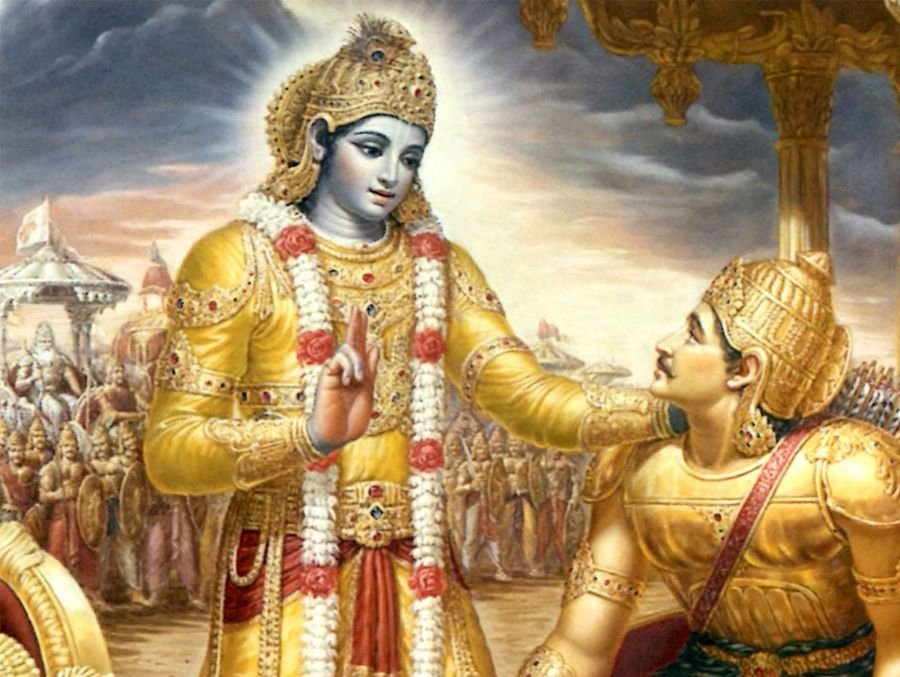(Image Courtesy Mahanidhiswami)
The Sacred Syllable OM, Also Known As Pranav, Was The Primaeval Sound
ओमित्येकाक्षरं ब्रह्म व्याहरन्मामनुस्मरन् |
य: प्रयाति त्यजन्देहं स याति परमां गतिम् || 8.13||
oṁ ityekākṣharaṁ brahma vyāharan mām anusmaran
yaḥ prayāti tyajan dehaṁ sa yāti paramāṁ gatim|| 8.13||
Shloka Translation
BG – Ch. 8- Ver. 13:
The greatest aim shall be attained by one who departs from the body while remembering Me, the Supreme Personality, and uttering the phrase Om.
Explanation
God made sound first in the beginning of creation. He created space using sound before continuing with the remainder of the creation process. The sacred syllable OM, also known as Pranava—the sound manifestation of the Brahman—was that primal sound. It portrays the Supreme Lord’s formless aspect, devoid of all characteristics and virtues.
The sound Om surrounds all of creation; it is eternal and boundless, just like God. As a result, it is also known as anahata nada. It is known as the maha vakya, or Great Sound Vibration of the Vedas, in Vedic philosophy, and is frequently linked to the beginning of Vedic mantras as bija (seed or core) mantra.
The vibrations of three letters: A… U… M… are stressed during correct chanting of the sacred word OM. With an open mouth and neck, one begins by making a “A” sound from the belly, which eventually merges into a “U” in the middle of the mouth. Finally, it concludes with a closed mouth chant of “M.”
Devotees regard the word Om as God’s impersonal form. The Praav sound is considered the goal of meditation in Ashtanga yoga. Shree Krishna is outlining the practise of meditation in relation to the ashtanga yoga sadhana in this line. He claims that chanting “m” while doing austerities and keeping the vow of celibacy is a good way to focus one’s mind on God.
Devotees who follow the bhakti yoga path choose to focus on the Lord’s personal Names. When they reflect on God’s personal Names and Forms, such as Ram, Krishna, Shiv, and others, they experience more sweetness in God’s bliss.
Our meditation will be put to the ultimate test when we die. Death is believed to be terribly painful, but those who are able to focus on God even in their final moments achieve Him. Their souls reach His holy dwelling after they leave the body. However, achieving such a condition is extremely difficult; it necessitates life-long practise.
Verse & what we can learn
In the Vedas, the sound “Om” is commended as a sign of brahman, the eternal essence. Shri Krishna closes the second technique of meditation, meditation on the name of Ishvara, by stating that whomever meditates on the sound of Om at the time of departure attains Ishvara.
Meditation on the sound of Om assists the seeker in breaking his bond with the finite ego and leading him to the infinite eternal nature. The important thing is to connect the sound “Om” with our concept of Ishvara. To put it another way, meditating on the sound of Om without identifying it with our favourite deity will be fruitless.
Only those who have diligently heard (“shravana”) and analysed (“mananam”) the knowledge of the eternal essence should meditate on Om. This is why Shri Krishna adds the phrase “remember me as Ishvara” to the Om chanting instruction.
To acquire knowledge and to implement that knowledge in life one needs to be mentally and physically active and healthy and for that daily meditation is a great tool.
There are various types of meditation like Buddhist meditation, heartfulness meditation, mindfulness meditation, meditation for stress, and each meditation benefits are countless. There are also numerous meditation techniques for beginners which help in practicing daily meditation so go ahead and start your journey towards a peaceful and balanced life.
The first technique is meditation on Ishvara’s magnificent cosmic form, and the second is meditation on Om. Both techniques necessitate the development of praanaas control. In the next shloka, Shri Krishna recognises this and offers an easier third technique.
Let’s learn to live with “The Gita” via Meditation Affinity…
